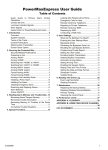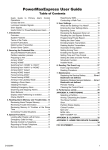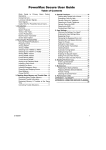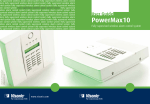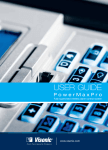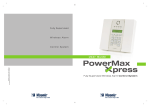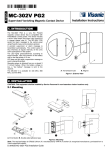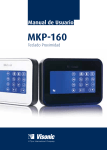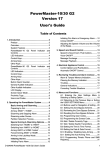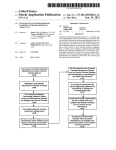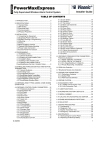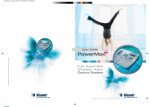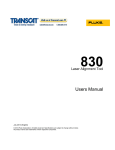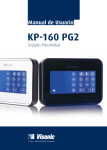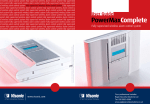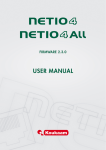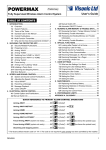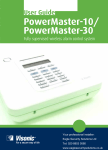Download PowerMaster-10
Transcript
User Guide
PowerMaster-10
Fully supervised wireless alarm control system
PowerMaster-10 User Guide
Table of Contents
1. Introduction ......................................................2
Preface.................................................................2
Overview..............................................................2
System Features ................................................2
Panel Indicator and Controls.............................3
LED Indicators ....................................................3
Control Keys........................................................4
Arming Keys ........................................................4
Other Keys...........................................................4
Internal Alarm Sounder......................................4
Audible Indicators ...............................................5
LCD Display ........................................................5
Screen Saver Mode ...........................................5
Users and Codes................................................5
2. Operating the PowerMaster-10 System.........6
Basic Arming and Disarming ........................6
Preparing to Arm ................................................6
Arming ‘AWAY’ ...................................................6
Arming ‘HOME' ...................................................6
Disarming and Stopping Alarm.........................6
Disarming after an Alarm or Trouble................7
Special Arming & Disarming Options .........7
Switching from ‘HOME’ to ‘AWAY’ ...................7
Switching from ‘AWAY’ to ‘HOME’ ...................7
Arming AWAY or HOME ‘Instant’ .....................7
Forced Arming AWAY or HOME ......................7
Arming in the Latchkey Mode ...........................8
Disarming under Duress....................................8
Using Keyfob Transmitters................................8
Initiating Alarms ...............................................9
Initiating Panic Alarm with Keyfobs..................9
Initiating Panic Alarm .........................................9
Initiating Fire Alarm ............................................9
Initiating Emergency Alarm ...............................9
Siren Alarms........................................................9
Chime ON/OFF...................................................9
3. Reviewing Troubles and Alarm memory .....10
Alarm & Tamper Memory ................................10
Troubles.............................................................10
Correcting Trouble Situations ........................11
4. Menus and Functions....................................12
A The Settings You Need................................12
B.1 Entering the User Settings Menu &
Selecting a Setting Option .............................. 13
B.2 Returning to the Previous Step or Exiting
the USER SETTINGS Menu .......................... 15
B.3 Buttons used for Navigation & Setting ... 15
C.1 Setting the Zone Bypass Scheme.......... 16
C.2 Reviewing the Zone Bypass Scheme .... 17
C.3 Recalling the Zone Bypass Scheme ...... 17
C.4 Programming User Codes....................... 19
C.5 Add / Delete Keyfob Transmitters .......... 21
C.6 Setting the Time & Time Format............. 23
C.7 Setting the Date & Date Format ............. 24
C.8 Enabling / Disabling Auto-Arming........... 25
C.9 Setting the Auto-Arming Time................. 25
C.10 Programming Private Phone and SMS
Reporting .......................................................... 26
C.11 Enabling / Disabling the Squawk Option
............................................................................ 29
C.12 Programming the Scheduler ................. 30
5. Event Reporting and Control by Telephone
and SMS ......................................................... 33
Event notifications by Telephone................... 33
Event notifications by SMS............................. 33
Remote Control by Telephone ....................... 33
Remote Control by SMS ................................. 34
6. Special Applications and Functions ........... 35
Looking after People Left at Home................ 35
Acknowledging “low battery” condition in
Keyfobs ............................................................. 35
7. Testing the System ....................................... 36
Periodic Test..................................................... 36
8. Maintenance .................................................. 38
Replacing the Backup Battery........................ 38
Replacing Wireless Devices Batteries ............. 38
Gaining access to 24-hour zones .................. 38
Cleaning the Control Panel ............................ 38
Event Log.......................................................... 39
Reading the Event Log ................................... 39
Exiting the Event Log ...................................... 39
APPENDIX A. GLOSSARY................................ 40
APPENDIX B. HOME FIRE ESCAPE PLANNING
......................................................................... 42
FCC STATEMENT.............................................. 43
D-302757
1
INTRODUCTION
1. Introduction
Preface
Dear Customer,
Thank you for choosing PowerMaster-10, a highly
advanced wireless alarm control system produced by
Visonic Ltd.
Also please make sure that you have the name and
telephone number of the monitoring station your
system will report to. If you ever call the monitoring
station to ask questions, you should be able to come
up with your "ACCOUNT NUMBER" used to identify
your alarm system to the monitoring station. Obtain
this information from your installer and write it.
Overview
The PowerMaster-10 is a wireless alarm system for
detecting and alerting in case of burglary, fire and a
variety of other security and safety hazards. In
addition, it can be used to monitor the activity of
disabled or elderly people left at home. System
status information is presented visually.
The PowerMaster-10 is governed by a control panel
(Figure 1) designed to collect data from various
sensors that are strategically located within and
along the perimeter of the protected site.
The alarm system can be armed or disarmed by a
variety of keyfobs and keypads using special
codes.
In the disarmed state, the system provides you
with visual status information, and initiates an alarm
if smoke is detected or upon disturbance in a 24hour zone (a zone which is active 24-hours a day).
In the armed state, the system will initiate an alarm
upon detection of disturbance in any one of the
armed zones.
The system identifies a wide range of events - alarms,
attempts to tamper with sensors and several types of
trouble. Events are automatically reported via PSTN
(telephone line) or optional GSM and Broadband
communication to monitoring stations (in digital or IP
form) and to private telephones (in tones and/or SMS
messages). The person receiving such a message is
expected to investigate the event and act accordingly.
IMPORTANT! All you need to know to secure your
premises can be found in Chapters 2 and 3 of this
manual.
If you are not familiar with some of the terms used
here, refer to Appendix A at the end of this guide.
Note: This system must be checked by a qualified
technician at least once a year.
System Features
Your PowerMaster-10 offers a large number of unique
features:
• Master / User Settings: Two user levels allow
different access types (see Chapter 4-C.4).
• Various reporting destinations: Events can be
reported automatically to monitoring stations,
private telephones and mobile phones of your
choice, and even by SMS if GSM is installed.
• 29 detector zones: Each detector zone is
identified by zone number, location and by name.
• Selective reporting: Your installer can determine
what type of events will be reported to which
destination.
• Multiple arming modes: AWAY, HOME, AWAYINSTANT, HOME-INSTANT, LATCHKEY and
BYPASS.
• Liquid crystal display (LCD): Plain-language
status information and prompts are displayed on
the front panel in large, clear text.
• Real-time clock: The present time is visible on the
display. This feature is also used for the log file by
providing the date and time of each event.
2
• Latchkey mode: An automatic “Latchkey”
message is sent to chosen telephones if the
system is disarmed by a “latchkey” user (a junior
family member, for instance). (See Chapter 2.)
• Access from remote telephones: You may
access the PowerMaster-10 from a remote
telephone and Arm/Disarm it or receive system
status information. (See Chapter 5).
D-302757
INTRODUCTION
• Numerical keys serve as function keys: When
the system is disarmed, the numerical keys are
used also to control various system functions. A
simple icon on each key identifies the task of that
key
• Distress calls: Miniature pushbutton portable
transmitters given to specific individuals may be
used for sending emergency calls for help.
• Data retrieval: You can obtain status information,
trouble information and review memorized alarm
events visually. (See Chapter 3).
• Disarming under duress: If a user is forcibly
compelled to disarm the system, he can do so
using a special code ("Duress Code") that disarms
the system apparently as usual, but sends a silent
alarm to the monitoring station (see chapter 2).
• Event log: System events are memorized in an
event log that stores the most recent 100 events,
each tagged with the time and date of the event.
You can access this log and review the past
events in case of need such as after a burglary.
(See Chapter 8).
• System supervision: All wireless peripherals
within the protected site send periodic keep alive
supervision messages. If such a message is
overdue, the PowerMaster-10 displays a 'missing'
trouble message. Your installer can disable this
feature if so desired.
• Looking after elderly, physically handicapped
and infirm individuals: The system can be
programmed to monitor people activity within the
protected area and send out an alert message if
no movement is detected in the area for a
predefined period of time (See Chapter 6).
• Battery supervision: The PowerMaster-10
continuously monitors the battery condition of the
sensors and devices in the system and displays a
‘Low Battery’ message whenever a battery in a
needs to be replaced within maximum 30 days..
Wireless sirens can still provide 2 siren alarms
before the siren becomes totally inactive.
Panel Indicator and Controls
1
2
3
20
4
5
6
7
9
10
12
8
11
13
14
15
16
17
18
19
Figure 1. Controls and Indicators
LED Indicators
No.
Indication
Function
2
Power (Green): Indicates that your system is properly connected to the power outlet.
3
Arm (Red): Lights when the system is in the armed state.
4
Chime (Green): Chime zones will chime when disturbed (see Chapter 2).
5
Trouble (Orange): Lights when the system is in a state of trouble (see Chapter 3).
D-302757
3
INTRODUCTION
Control Keys
No.
Indication
Function
7
NEXT: Advance from item to item within a given menu.
8
BACK: Move one step back within a given menu.
9
OK: Review status messages one by one and also select a displayed option.
Arming Keys
No.
Indication
Function
12
AWAY:
Arming when nobody is at home
10
HOME:
Arming when people remain at home.
14
INSTANT: Canceling the entry delay upon arming (AWAY or HOME)
11
DISARM / OFF: Disarming the system and stopping alarms
16
PARTITION: Partition selection (for future use)
Other Keys
No.
Indication
Function
13
Chime ON/OFF
15
Reviewing the event log
17
Emergency (hold for 2 sec.)
18
Fire (hold for 2 sec.)
19
Press both buttons simultaneously for panic alarm
+
Internal Alarm Sounder
The PowerMaster panel has a high power siren built-in that sounds in case of alarm, to deter intruders and to
summon help.
Alarm Type
Burglar / 24
hour/ Panic
Fire
Test*
Graphic Representation of Signal
–––––––––––––––––––––––––––––––
Verbal Description of Signal
ON continuously
– – – – – – – – – – – – .................
–– (both external and internal sirens)
ON - ON - ON - pause - ON - ON - ON - pause.....
ON for 2 seconds (once)
* Not included in all models
4
D-302757
INTRODUCTION
Audible Indicators
The sounds you will hear while using the control panel are:
Sound
Definition
Single beep, heard whenever a key is pressed
Double beep, indicates automatic return to the normal operating mode (by timeout).
Three beeps, indicates a trouble event
☺
Happy Tune (- - - –––), indicates successful completion of an operation.
Sad Tune (–––––), indicates a wrong move or rejection
LCD Display
The display is a single line, backlit 16-character LCD
used to display system status and events, time and
date, programming instructions and also an event log
file which is accompanied by the date and time of
each event. The normal display alternates with the
time and the system status, for example:
READY
HH:MM
(alternating)
READY MEMORY
Screen Saver Mode
For security reasons, it is sometimes required to hide
the status indication (LCD and LED display) from a
potential intruder. If the Screen Saver option is
enabled by the installer, then if no key is pressed for
more than 30 seconds, the display will read
“PowerMaster-10” and the LEDs will stop indicating
any status. Pressing any key will resume the normal
status display. Pressing the Fire or Emergency keys
will also initiate the Fire or Emergency alarm.
If configured by the installer for additional security, the
system will ask you to enter your user code as well
before resuming the normal display.
Users and Codes
As a master User (User No.1) you will need a 4-digit
security code to master the system (code 0000 is not
allowed).You can also authorize 7 other persons to
use the system by providing them with their own
security codes (see Chapter 4-C.4).
Security codes are used mainly to arm and disarm
the system or to access information that is restricted
only to authorized users (see Chapter 4).
D-302757
Moreover, you can obtain up to 8 multi-function
portable keyfob transmitters that will allow you and
the other users to easily arm, disarm and control the
system without accessing the panel, including from
outside the premises (see Chapter 2 and 4-C.5).
The Duress Code enables you to disarm the system
using a special code that sends a silent alarm to the
monitoring station (see chapter 2).
5
OPERATING THE POWERMASTER-10 SYSTEM
2. Operating the PowerMaster-10 System
For more information regarding terms used in this
chapter, refer to the glossary in Appendix A.
Basic Arming and Disarming
Arming ‘AWAY’
If the system is READY and quick arming is allowed,
proceed as shown:
PRESS
Following are a set of procedures for performing
basic arming and disarming of the alarm system.
RESULTANT DISPLAY
ARMING AWAY
PLEASE EXIT NOW
Vacate the premises
Preparing to Arm
Before arming, make sure that READY is displayed.
READY HH:MM
This means that all zones are secured and you may
arm the system any way you choose.
If at least one zone is open (disturbed) the display
will read:
NOT READY HH:MM
This means that the system is not ready for arming
until all zones are secured (closed).
To review the open zones click
. The details
and location of the first open zone detector (usually an
open door or window sensor) will be displayed.
To fix the open zone, locate the sensor and secure it –
see "device locator" below. Each click of the
button will display another open zone or trouble
indication.
Note: To quit at any stage and to revert to the
.
"READY" display, click
Device Locator: The PowerMaster-10 system has a
powerful device locator that helps you to identify open
or troubled devices indicated on the LCD display
which operates as follows:
While the LCD displays an open or faulty device, the
LED on the respective device flashes indicating "it's
me". The "it's me" indication appears after a certain
time delay of max. 16 seconds and will last for as long
as the LCD displays the device.
It is highly recommended to fix the open zone(s), thus
restoring the system to the state of “ready to arm”. If you
do not know how to do this, consult your installer.
IMPORTANT! All arming procedures below are
based on the assumption that quick arming has been
enabled by the installer. If quick arming is disabled,
the PowerMaster-10 will prompt you to enter your
security code before arming as follows:
ENTER CODE
6
↓
↓
(Exit delay)
AWAY
____
ARM indicator lights steadily during the armed
state.
Arming ‘HOME'
If all perimeter zones are READY, and quick arming
is allowed, proceed as shown:
PRESS
RESULTANT DISPLAY
ARMING HOME
Move to interior zone
↓
(Exit delay)
↓
AWAY HH:MM
ARM indicator flashes during the armed state.
Disarming and Stopping Alarm
Enter the protected premises via a delayed zone.
Upon detecting your entrance, the system will start
sounding the entry delay beeps alerting you to disarm
the system before the entry delay ends. To disarm the
system proceeds as shown:
PRESS
RESULTANT DISPLAY
CODE
[Enter Code]
____
Code
READY
HH:MM
ARM indicator extinguishes during the disarmed
state.
Disarming the system also stops the siren alarm,
irrespective of whether the alarm was initiated during
the armed or the disarmed state.
D-302757
OPERATING THE POWERMASTER-10 SYSTEM
Disarming after an Alarm or Trouble
Arming AWAY or HOME ‘Instant’
After disarming, different displays may appear
indicating that the system is in a state of TROUBLE
(TRBL) or alarm MEMORY and will also sound
once per minute. To find out the
trouble beeps
troubles that have been detected, or which zone
alarmed, see Chapter 3.
Pressing the
button during the exit delay will
arm the system in the "Instant' mode, i.e. without an
entry delay. Therefore, any detection in any zone will
trigger an immediate alarm.
If you wish to arm AWAY-INSTANT, proceed as
follows.
Upon eliminating the cause for trouble the TRBL
display will disappear, the TROUBLE indicator will
extinguish and the trouble beeps will stop.
PRESS
The MEMORY message will disappear only upon
rearming the system.
[Enter code]
RESULTANT DISPLAY
ENTER CODE
Code
____
ARMING AWAY
IMPORTANT! If the trouble beeps bother you, disarm
the system again (even though it is already disarmed).
This will cancel the trouble beeps for 4 hours.
ARMING INSTANT
(alternating)
PLEASE EXIT NOW
Special Arming & Disarming
Options
In addition to basic arming, PowerMaster-10
provides you with several advanced arming and
disarming options:
Switching from ‘HOME’ to ‘AWAY’
Do not disarm the system - just press
. The
response will be the same as in ARMING AWAY above.
Vacate the premises before the exit delay expires.
Switching from ‘AWAY’ to ‘HOME’
Do not disarm the system - simply press
.
Since this operation reduces the security level, the
PowerMaster-10 will ask you to key in your master
user code or user code, thus making sure that you
are an authorized user.
PRESS
[Enter code]
Move to interior zone
RESULTANT DISPLAY
ENTER CODE
Code
____
Vacate the premises
ARM indicator lights during the armed state.
Forced Arming AWAY or HOME
Forced arming allows you to arm the system even if
one or more zones are disturbed and the
"NOT READY" message is displayed.
Automatic forced arming operates only if this option
was enabled by the installer while programming your
system. All disturbed zones will be automatically
bypassed - they will not be armed. The protected
site will not have maximum protection.
Note: When forced arming is carried out, the buzzer
“protests” by emitting a continuous tone during the exit
delay until the last 10 seconds of the delay. You can
silence this signal by pressing the arming button again.
If forced arming is enabled and you wish to arm the
system when NOT READY is displayed, proceed as
shown:
PRESS
[Enter code]
RESULTANT DISPLAY
ENTER CODE
Code
____
ARMING AWAY
ARMING HOME
↓ (Exit delay) ↓
ARM HOME HH:MM
ARM indicator flashes during the armed state.
↓ (Exit delay) ↓
AWAY
PLEASE EXIT NOW
(to mute the buzzer)
Vacate the premises
↓
(Exit delay)
↓
AWAY
ARM indicator lights during the armed state.
Remember: Forced arming compromises security!!
D-302757
7
OPERATING THE POWERMASTER-10 SYSTEM
Forced arming “HOME” is performed in a similar
manner, as follows:
PRESS
[Enter code]
RESULTANT DISPLAY
ENTER CODE
Code
____
ARMING HOME
(to mute the buzzer)
Go to interior zone
PLEASE EXIT NOW
↓ (Exit delay)
HOME
↓
HH:MM
ARM indicator flashes during the armed state.
Using Keyfob Transmitters
Using portable keyfobs (KF-234 PG2) you can also
conveniently arm and disarm the system from
outside the premises, initiate "panic alarms" and
even use it as a remote control.- see figure 2.
The KF-234 PG2 commands are authenticated and
encrypted using high security AES - 128 encryption
standard, hence malicious “code grabbing” is virtually
impossible.
Arming & disarming with Keyfobs:
To arm or disarm the system press the respective
key (see Figure 2). The keyfob will confirm with a red
LED blink and buzzer beep and will transmit your
request to the panel.
ARM AWAY
Arming in the Latchkey Mode
ARM HOME
This mode, if enabled by the installer, is useful for a
parent at work who wants to be sure that his children
have returned from school and have disarmed the
system. A special “latchkey” message will be sent
out when the system is disarmed by a “latchkey
user”.
Latchkey users are holders of user codes 5 through 8 or
users of Keyfob transmitters 5 through 8. The latchkey
message is considered an alert and not an alarm, and
is therefore sent to the private telephones programmed
by the user as targets for alert messages.
Latchkey arming is possible only when you arm
“AWAY”. To arm in the Latchkey mode, proceed as
follows:
DISARM
PRESS
RESULTANT DISPLAY
ARMING AWAY
(Within 2 seconds)
ARMING LATCHKEY
(alternating)
PLEASE EXIT NOW
↓ (Exit delay)
↓
AWAY
Note: Latchkey must be enabled by your installer.
Vacate the premises
ARM indicator lights during the armed state.
Disarming under Duress.
If you are forcibly compelled to disarm the system,
enter the duress code (2580 by default) or another
code set by the installer. Disarming will take place
normally but a silent alarm will be transmitted to the
monitoring station.
¿ AUX
Figure 2. KF-234 PG2 Keyfob Transmitter
If the operation is successfully completed, the green
LED lights momentarily and a "happy tune" is heard.
If the operation cannot be completed, for example,
when the system is "not ready", the red LED lights
steadily and a "sad tune" is heard.
Arming in Latchkey mode (*):
Pressing AWAY twice within 2 seconds initiates
Latchkey arming, if enabled by the installer.
Using the AUX key (¿) (*):
The AUX key on the KF-234 PG2 keyfob can be
configured by the installer to provide you with any of
the following options:
A. Arming the system in the INSTANT mode (*):
This is the default option. Pressing the AUX (¿)
button immediately after arming, during exit
delay, will arm the system in "instant" mode.
This means cancelling the entry delay causing
the system to trigger an immediate alarm upon
entering the protected premises via any zone.
To prevent false alarms, you, and other keyfob
holders, must disarm the system by pressing the
DISARM ( ) button on your keyfobs before
entering the protected premises.
B. Skip exit delay: Pressing the AUX (¿) button
during the exit delay will immediately stop the
exit delay beeps.
C. Controlling a gate or another electrical
device: Pressing the AUX (¿) button
opens/closes an electrically-controlled gate, or
controls a chosen electrical device via PGM
output of the system.
(*) For further information - see Appendix A.
8
D-302757
OPERATING THE POWERMASTER-10 SYSTEM
Initiating Alarms
Following are various methods that may be used for
initiating alarms.
Initiating Panic Alarm with Keyfobs
Using the KF-234 PG2 you can initiate a PANIC
and HOME
alarm by pressing both AWAY
keys simultaneously for 2 seconds.
Low Battery Indication
If the battery power is near the end of its life, the keyfob
LED indicates this by flashing the yellow light at the end
of keyfob activation. It will also send a "low battery"
signal to the panel which will be indicated on the LCD
display as a trouble message (see Chapter 3). When
"low battery" occurs, you must replace the battery within
2-3 weeks otherwise your keyfob will stop functioning.
Acknowledging “low battery” condition
Some regulations and institutions require the user to
acknowledge when the keyfob enters the “low
battery” condition. The acknowledge procedure is
described in Chapter 6.
Initiating Panic Alarm
You can generate a panic alarm manually in the
disarmed and armed states alike. The sequence will
be as shown:
PRESS
RESULTANT DISPLAY
PANIC ALARM
simultaneously
and then key in
To stop the alarm, press
your valid user code.
Initiating Emergency Alarm
You can generate a silent emergency alarm
manually in the disarmed and armed states, as
follows:
PRESS
for 2 seconds
RESULTANT DISPLAY
EMERGENCY
Then, if or when the system
is in the disarmed state:
READY HH:MM
(alternating)
READY MEMORY
Siren Alarms
The maximum operating time of the siren is
configured by the installer according to local
regulations.
Continuously ON when initiated by a burglar zone
or a 24-hour zone, and when a user initiates a “panic
alarm”.
When initiated by a fire zone (smoke is detected) ON ON - ON - pause - ON - ON - ON - pause - ........
and so on.
If there is nobody around to disarm the system upon
alarm, the siren will sound for the time duration set
by the installer - then will stop. If enabled, the strobe
light will keep flashing until the system is disarmed or
the siren will stop as configured by the installer.
READY HH:MM
To stop the alarm, press the
then key in your valid user code.
button and
Initiating Fire Alarm
(This function is disabled in ACPO compliant version).
You can generate a fire alarm in disarmed & armed
states, as follows:
PRESS
for 2 seconds
D-302757
RESULTANT DISPLAY
FIRE ALARM
Then, if or when the system
is in the disarmed state:
READY HH:MM
(alternating)
READY MEMORY
Chime ON/OFF
You can disable / enable the chime zones (see
Appendix A) by alternate clicking of the <8> key, as
shown below:
PRESS
RESULTANT DISPLAY
CHIME ON
CHIME OFF
READY
↓
HH:MM
CHIME indicator lights steadily when “chime on”
is selected.
9
REVIEWING TROUBLES AND ALARM MEMORY
3. Reviewing Troubles and Alarm memory
Alarm & Tamper Memory
Troubles
The PowerMaster-10 retains in it's memory alarm and
“tamper” events that occurred during the last arming
period.
Note: Alarm events are memorized only after expiry of
the “abort period” (see Appendix A). This means that if
you disarm the system immediately - before the abort
period expires - there will be no memory indication
A. Indication of Trouble condition
A. Indication of Alarm & Tamper Condition
If the system is disarmed following an alarm event, a
flashing MEMORY message will be displayed, as
follows:
READY
HH:MM
(alternating)
READY MEMORY
or, if the system is not ready for arming NOT READY
HH:MM
(alternating)
NOT READY
MEMORY
B. Displaying Alarm & Tamper Information
To review memory content, click
button.
EXAMPLE: An alarm was triggered because the garage
door - zone No. 12 – was opened but then closed. In
addition, the bedroom motion detector - zone No. 7 sent a “Tamper” message because its cover had been
removed.
PRESS
RESULTANT DISPLAY
READY
HH:MM
Z12 ALARMED
(alternating)
If the system detected a trouble condition in any of the
enrolled devices, the TROUBLE indicator illuminates,
3 beeps are sounded once per minute and a flashing
TRBL message is displayed, as follows.
READY
HH:MM
(alternating)
READY
TRBL
or, if the system is not ready for arming NOT READY
HH:MM
(alternating)
NOT READY
TRBL
B. Displaying Trouble Information
All trouble messages need to be reviewed and
corrected as described below:
EXAMPLE: The kitchen device - zone No. 9 - has
reported a low battery – the living room device zone
No. 15 - has been inactive, and an attempt to
communicate a message to your telephone has
failed. However, these troubles do not prevent the
system from being “ready to arm”.
To review the source of the current troubles one by
button repeatedly as shown
one, click the
below:
PRESS
RESULTANT DISPLAY
READY
HH:MM
Z09 LOW BATTERY
(alternating)
GARAGE DOOR
Z09 CONTACT
(alternating)
Z07 TAMPER-OPEN
KITCHEN
(alternating)
BEDROOM
READY
↓
HH:MM
In response to additional clicking of the
button, the display shows details of other events
retained in open tamper (if any), or reverts to its
initial state (see A above).
If the system is NOT READY, the display will first read
the open zones and then alarm memory events.
↓
Z15 MISSING
(alternating)
Z15 MOTION SENS.
(alternating)
LIVING ROOM
↓
COMM. FAILURE
↓
READY HH:MM
Remember! The memory indication and content will
be cleared upon the next arming of the system.
10
D-302757
REVIEWING TROUBLES AND ALARM MEMORY
IMPORTANT! If the trouble beeps bother you, disarm
the system again (even though it is already disarmed).
This will cancel the trouble beeps for 4 hours.
C. Reviewing Memory & Troubles at the Same Time
If alarms / tamper events are retained in the alarm
memory and at the same time a state of trouble
exists, the display will first read the alarm memory
followed by trouble events, as described in sections
A & B above.
Correcting Trouble Situations
The trouble indications (illuminated TROUBLE
indicator and flashing TRBL message) are cleared
once you eliminate the cause of trouble. The table
below describes the system faults and respective
corrective actions. If you do not know how to cope
with a trouble situation, report it to your installer
and seek his advice.
Fault
What it means
1-WAY
The device functions but can not "hear" the panel. The control panel cannot
configure or control the device. Battery consumption increases.
AC FAILURE
There is no power to gas sensor
AC SUPPLY FAILURE
There is no power and the system is working on backup battery power
CLEAN ME
The fire detector must be cleaned
COMM. FAILURE
A message could not be sent to the monitoring station or to a private telephone (or a
message was sent but was not acknowledged)
CPU LOW BATTERY
The backup battery within the control panel is weak and must be replaced (see
Chapter 7 - Replacing Backup Battery).
CPU TAMPER
The control panel was physically tampered with or its cover was opened, or it was
removed from wall.
FUSE TROUBLE
The PGM fuse is burnt out or overloaded.
GAS TROUBLE
Gas detector failure
GSM NET FAIL
The GSM communicator is not able to connect to the cellular network.
JAMMING
A radio-frequency signal which is blocking all communication frequency channels
between the sensors and control panel is detected.
LOW BATTERY
The battery of the indicated device is near the end of its useful life.
MISSING
A device or detector has not reported for some time to the control panel.
NOT NETWORKED
A device was not installed or not installed correctly, or, cannot establish
communication with the control panel after installation.
RSSI LOW
The GSM communicator has detected that GSM network signal is weak
SIREN AC FAILURE
There is no power to the siren
LINE FAILURE
There is a problem with the telephone line
D-302757
11
MENUS AND FUNCTIONS
4. Menus and Functions
This chapter explains the user programming features of your PowerMaster-10 system and allows you to tailor
the PowerMaster-10 system according to your specific needs. The chapter is divided into three sections, as
follows:
Part A – Provides you with a general description of available User Setting options.
Part B – Guides you how to enter/exit the User Settings menu and how to select the desired setting options.
Part C – Guides you to execute the selected settings.
A The Settings You Need
The installer provides you with a ready-to-use alarm system, but a number of settings may still be needed. The
User Settings menu provides you with essential options that allow you to adapt the system to your specific
needs, to operate it as you desire and to upgrade it when necessary.
Below is a list of the User Settings menu options. A more detailed list is provided in section B.1. Detailed setting
instructions for options 1 to 12 are provided in sections C.1 to C.12.
1. Setting the zone bypass scheme(*)
2. Reviewing the zone bypass scheme(*)
3. Recalling the zone bypass scheme(*)
4. Programming user codes(**)
5. Add / delete keyfob transmitters (**)
6. Setting the time & time format(**)
7. Setting the date & date format(**)
8. Enabling / disabling auto-arming(**)
9. Setting the auto-arming time(**)
10. Programming private phone numbers(**)
11. Enabling / disabling the squawk option(**)
12. Programming the scheduler(**)
*
These menu options are available only if the bypass option was enabled by the installer.
** This option can be accessed only by the master user using the master user code.
Note 1: Although the user settings are your responsibility, you may request your installer to perform them for
you (except for the user codes which you desire to keep secret).
Note 2: Some options may not be available on your PowerMaster-10 system.
12
D-302757
MENUS AND FUNCTIONS
B.1 Entering the User Settings Menu & Selecting a Setting Option
The following procedure describes how to enter and move within the User Settings menu.
Detailed descriptions of the User Setting options are provided at the end of the procedure.
To exit the User Settings menu – see section B.3.
L
1. You can enter the "User Settings" menu only when the system is disarmed.
2. Carefully read the section titled "Additional Information" according to the indicated references 1 etc – see
table at end of this section.
A. To Enter the User Settings Menu
Make sure the system is disarmed and then press the
repeatedly until the display reads "USER SETTINGS".1
1.
READY 00:00
2.
USER SETTINGS
Press
ENTER CODE:
The screen will now prompt you to enter your user code.
to confirm
Enter your User Code.2
CODE
3.
button
SET BYPASS
The display reads the first Setting option of the User Settings menu
[SET BYPASS].3
B. To Select a Setting Option
5.
SET BYPASS
or
6.
TIME & FORMAT
Continue to the selected
setting option in C.1 - C.12
Click the
or
button until the display reads the desired
setting option, for example, "TIME & FORMAT".
When the desired setting option appears on the display, press the
button to enter the setting process.
The remainder of the procedures for the selected setting options is provided
in sections C.1 to C.12.
Additional Information (section B.1)
1
Display shown in disarm state when all zones are secured (00:00 or other digits show present time).
2
a. If you have not already changed your personal code number, use the default setting – 1111.
b. The Master User has access to all User Settings options. All other users have access only to the Bypass
options.
3
The bypass options will be displayed in the User Settings menu only if enabled by the installer. Otherwise, the
first user setting option displayed will be [USER CODES].
D-302757
13
MENUS AND FUNCTIONS
B. User Setting Options Menu
Click the
button.
button until the display reads the desired setting option and then press the
SET ZONE BYPASS
REVIEW BYPASS
Use to quickly review the Bypass Scheme i.e. which zones are bypassed. For
further details and reviewing procedure see section C.2.3
RECALL BYPASS
Use to Recall the last used bypassed scheme for reuse in next arming period.
For further details and recalling procedure see section C.3.3
USER CODES
Use to program your Master User secret access code and the seven codes of
the other users. For further details and programming procedure see section
C.4.
KEYFOBS
Use to add new Keyfob Transmitters or to delete Keyfob Transmitters when
lost. For further details and programming procedure see section C.5.
TIME & FORMAT
Use to set the time clock to show the correct time and time format. For further
details and programming procedure see section C.6.
DATE & FORMAT
Use to set the calendar date to show the correct date and date format. For
further details and programming procedure see section C.7
AUTO-ARM ENABLE
AUTO-ARM TIME
PRIVATE REPORT
SQUAWK
SCHEDULER
<OK> TO EXIT
Returns to
first option
14
Use to set the Zone Bypass Scheme i.e. to bypass (exclude) faulty or
unsecured ("disturbed") zones, or to clear a bypassed zone (unbypass). For
further details and programming procedure see section C.1.3
Use to enable or disable the Automatic Daily Arming option at predefined times
(see Auto-Arm Time setting). For further details and programming procedure
see section C.8.
Use to set the predetermined time for the Automatic Daily Arming if enabled
(see Auto-Arm Enable setting). For further details and programming procedure
see section C.9.
Use to program the four private telephone numbers for reporting alarm and
other event messages to private subscribers. For further details and
programming procedure see section C.10
Use to enable or disable the squawk sound i.e. arm / disarm feedback
indication. For further details and programming procedure see section C.11.
Use to set the daily / weekly time schedule for start & stop activation of
devices connected to the PGM output. For further details and programming
procedure see section C.12.
Use to exit from the “USER SETTINGS” menu back to Main Menu. For further
details see section B.3.
D-302757
MENUS AND FUNCTIONS
B.2 Returning to the Previous Step or Exiting the USER SETTINGS Menu
During the setting process it is frequently necessary to return to the previous setting step or option (i.e. "to go
one level up") or to exit the User Settings menu.
A. To Move One Level Up
To move one level up during the setting process, click the
one level up or to the previous setting step:
button once or more. Each click will take you
B. To Exit the USER SETTINGS Menu
Any screen
To exit "USER SETTINGS", move up the menu by pressing the
button repeatedly (see above) until the display reads [<OK> TO EXIT] or
alternatively; press the
button once which brings you
immediately to the exit screen.
or
<OK> TO EXIT
When the display reads [<OK> TO EXIT], press
READY 12:00
The system exits the “User Settings menu and returns to the normal
disarm state while showing the READY display.
B.3 Buttons used for Navigation & Setting
The keypad's buttons are used for various functions when programming. The following table provides a detailed
description of the function or use of each button.
Button
0-9
D-302757
Definition
Navigation / Setting Function
NEXT
Use to move / scroll forward to the next menu options.
BACK
Use to move / scroll backward to the previous menu options.
OK
Use to select a menu option or to confirm a setting or action.
HOME
Use to move one level up in the menu or to return to previous setting step.
AWAY
Use to jump back to the [<OK> TO EXIT] screen to quit programming.
OFF
Use to cancel, delete, clear or erase setting, data, etc.
Numerical keypad used to enter numerical data.
15
MENUS AND FUNCTIONS
C.1 Setting the Zone Bypass Scheme
Bypassing permits arming only part of the system while allowing free movement of people within certain zones
when the system is armed.
It is also used to temporarily remove from service faulty zones that require repair work or to deactivate a sensor
if, for example, you are decorating a room.
♦ Here you can set the Zone Bypass Scheme i.e. to scroll through the list of registered (enrolled) sensors to
your PowerMaster-10 system and to Bypass (deactivate) faulty or disturbed sensors (either READY or
NOT-READY) or to Clear (reactivate) BYPASSED zones (sensors).
Once you have set a Bypass Scheme you can use the following 3 options:
>
To quickly review the bypassed zones – refer to section C.2.
>
To quickly clear a bypassed zone i.e. to reactivate the bypassed zone – refer to section C.2.
>
To repeat (recall) the last used zone bypassing scheme – refer to section C.3.
L
1. Zones will be bypassed throughout one disarm-arm period only. Disarming the system after arming will
suspend the entire bypassing scheme but you can recall and reuse it as described in section C.3.
2. Fire zones cannot be bypassed.
3. Carefully read the section titled "Additional Information" according to the indicated references
1
etc – see
table at end of section C.3.
REMEMBER – ZONE BYPASSING COMPROMISES SECURITY!
A. To Bypass a Zone
1.
SET ZONE BYPASS
Z01: READY
Enter the USER SETTINGS menu and select the [SET ZONE BYPASS] option
button to confirm.1
and press the
The first zone, Z01, is displayed. 2
Living Room
2.
or
Z04: NOT READY
3.
Kitchen
4.
<OK> TO BYPASS
Click the
or
button until the display reads the zone you wish
to bypass (or clear bypass), for example, "Z04" for Zone 04. After several
seconds the LED on the respective device starts flashing indicating "it's me".
When the display reads the zone you wish to bypass press
confirm.
to
The display now reads [<OK> TO BYPASS]. 3
To bypass the selected zone press
5.
16
Z04: BYPASSED
A "Happy Tune" ☺ sounds and the updated zone status is now displayed i.e.
[Z04: BYPASSED]. 5
D-302757
MENUS AND FUNCTIONS
B. To Clear a Bypassed Zone
6.
Z04: BYPASSED
Repeat steps 1 to 2 above.
7.
Kitchen
<OFF> TO CLEAR
8.
When the zone you wish to clear bypass appears on the display (for
to confirm. You can also identify the device
example, "Z04"), press
by looking for the "it's me" LED indication on the displayed device.
The display now reads [<OFF> TO CLEAR]. 3
To clear the bypassed zone press the
Z04: READY
button.
A "Happy Tune" ☺ sounds and the updated zone status is now displayed,
i.e. [Z04: READY] or [Z04: NOT READY]. 6
C.2 Reviewing the Zone Bypass Scheme
♦ Here you can quickly review the Bypass Scheme i.e. the zones that are set to be bypassed during the next
arming session.
1.
REVIEW BYPASS
2.
BYPASS LIST
or
3.
Enter the USER SETTINGS menu and select the [REVIEW BYPASS] option
button to confirm. 1
and press the
The display reads [BYPASS LIST]
Click the
or
buttons repeatedly to review all bypassed
button to
zones in ascending numerical order. When done, click the
exit. 6
Z04: BYPASSED
Kitchen
C.3 Recalling the Zone Bypass Scheme
♦ Use this option to repeat (recall) the most recent Bypassed Scheme for use during the next arming session.
1.
RECALL BYPASS
Enter the USER SETTINGS menu, select the [RECALL BYPASS] option and
button to confirm. 1
press the
2.
<OK> TO RECALL
The display now reads [<OK> TO RECALL]. 4
To recall the last used bypass scheme press
3.
Bypass RECALLED
☺ Return to step 1
D-302757
.
A "Happy Tune" ☺ sounds. The display reads [Bypass RECALLED] and
then returns to “USER SETTINGS" step 1. 6
17
MENUS AND FUNCTIONS
Additional Information (section C.1 – C.3)
1
2
3
For detailed instructions on how to select the Setting Options – refer to section B.1 and section B.2.
a. The STATUS to the right of the zone number indicates whether the zone is READY, NOT-READY or
BYPASSED.
b. In the example on the right the display reads [Z01: READY] alternating with [Living Room].
a. If the zone you selected is "not bypassed", the display prompts you to press [<OK> TO BYPASS]. However, if
the zone you selected is already "bypassed", the display prompts you to press [<OFF> TO CLEAR].
b. To abort and return to the previous step press
4
5
6
18
or
The display now prompts you to press [<OK> TO RECALL] i.e. to repeat the last used bypass scheme. If you
wish to abort and return to the User Setting menu, press
.
You can now repeat steps 2 - 5 to bypass or clear another zone. To end this session and to select other
menu options or to quit programming - follow the instructions in section B.2.
You can now select another option in the User Setting menu (see section B.1), or quit programming (see
section B.2).
D-302757
MENUS AND FUNCTIONS
C.4 Programming User Codes
The PowerMaster-10 system allows you to authorize up to 8 people to arm and disarm the system by providing
each with a unique 4 digit personal security code, and assigning them with different security levels and
functionalities. There are two types of users: Master User and User, The table below summarizes the different
operations that can be performed by different users:
User type
Function
Master User Arm/disarm
Zone bypass
Authorize 7 other user codes
Set user codes
Report to private
Enroll/delete keyfob
Automatic arming
Enable squawk
Set date and time format
Read event log
Arm/disarm
User
Zone bypass options
The 8 user codes are assigned as follows:
User Code 1 is assigned to the Master User of the system (i.e. the owner). It is the only user code that allows
access to the User Setting menu. The default setting of the Master User code 1 is 1111. This code cannot be
erased and must be replaced with a secret code as soon as possible.
User Codes 2-4 are assigned to family members, co-workers etc. They enable arming and disarming of the
system as defined by the Master User. They can access the "User Setting" menu only for "zone bypassing"
provided this option is enabled in the Installer menu.
User Codes 5-8 are the same as user codes 2-4 but are assigned to "Latchkey" (child monitor) users. For a
detailed explanation of the Latchkey application see Chapter 2 (Arming with Latchkey) and Appendix A.
♦ Here you can program (or edit) the 8 User Codes and thereby define which will be authorized to arm and
disarm.
L
1. The default setting 1111 of Master User Code 1 is the same for all PowerMaster-10 systems and is
known to many other people. Therefore, we highly recommend that you immediately replace it with a
unique secret code.
2. Code "0000" is not valid! Do not use it.
3. The duress code (2580 by default), which is set in the installer menu, cannot be selected as a normal
user code. Any attempt to program it will be rejected by the system.
4. Carefully read the section titled "Additional Information" according to the indicated references
see table at end of this section.
D-302757
1
etc –
19
MENUS AND FUNCTIONS
To Program a User Code
1.
USER CODES
Enter the USER SETTINGS menu, select the [USER CODES] option and
button to confirm. 1
press the
2.
user code 1
The first user code "user code 1" is displayed. 2
Click the
or
button until the display reads the User Code
you wish to program, for example, "user code 4".
or
3.
user code 4
4.
user code 4
327
5.
user code 4 5327
When the user code you wish to program appears on the display, press
to confirm.
To program or edit the code, use the numerical keypad to enter the 4 digit
code (e.g. 5327) at the position of the blinking cursor. 3 4
to confirm.
When done, press
A "Happy Tune" ☺ sounds. The display confirms the saved code. 5 6
☺ Return to step 3
Additional Information (section C.4)
1
2
3
For detailed instructions on how to select the setting options – refer to section B.1 and section B.2.
The display shows the 1st User Code (Master User) in the list of 8 User Codes. If you have not yet
changed the default code 1111, we recommend that you change it now.
a. The display shows the user code currently programmed in this location (e.g. 5327).
b. The cursor blinks on the first digit of the code.
c. If the location is free the display will be blank ( - - - - ).
20
4
You can move the cursor to the next or previous digit using the (
/
Pressing the
button erases the digit of the cursor + all digits right of the cursor.
5
The new code is now displayed without the cursor.
6
You can now repeat steps 3 - 5 to program or edit another user code. To end this session and to
select other menu options or to quit programming – follow the instructions in section B.2.
) buttons.
D-302757
MENUS AND FUNCTIONS
C.5 Add / Delete Keyfob Transmitters
Each of the 8 PowerMaster-10 users may be provided with a portable keyfob transmitter to exercise better,
quicker and safer arming/disarming and other control functions. Each keyfob should be assigned with a serial
No. (1-8) that corresponds to user No. (1-8) and enrolled into the PowerMaster-10 system.
♦ Here you can add (enroll) the 8 Keyfob transmitters or delete keyfobs as required.
L
1. Before anything else, gather up all keyfob units you intend to enroll and make sure they all have
batteries installed and that they are active (the LED blinks upon pressing any of the buttons).
2. Carefully read the section titled "Additional Information" according to the indicated references1 etc – see
table at end of this section.
A. To Add (Enroll) a Keyfob
1.
KEYFOBS
2.
ADD NEW KEYFOB
3.
ENROLL NOW or
Enter the USER SETTINGS menu, select the [KEYFOBS] option and press
button to confirm. 2
the
The display will read [ADD NEW KEYFOB]. 4
To enroll a new keyfob press
.
The display offers you two alternative methods to enroll a keyfob:
ENTR ID:xxx-xxxx
4a.
DEVICE ENROLLED
☺ Go to step 5
4b.
ID No. 300-5786
ID ACCEPTED
☺ Go to step 5
5.
K01:keyfob
A: ENROLL NOW: Press the AUX ¿ button on the selected keyfob for
several seconds until the red LED turns on and then release the button. 1
This procedure completes the enrollment.
If enrollment was successfully completed, a "Happy Tune" ☺ sounds and
the display reads [DEVICE ENROLLED] for a short duration and then changes
to read the keyfob's details. Continue to step 5.
B: ENTER ID (Pre-enrollment): Enter the 7-digit number that appears on
the keyfob sticker and then press
to confirm. To complete the
enrollment procedure see note 6 in the Additional Information table bellow. 7
If a valid ID was entered, a "Happy Tune" ☺ sounds and the display reads
[ID ACCEPTED] for a short duration and then changes to read the keyfob's
details. Continue to step 5.
The display shows the allocated keyfob serial No (user No.), which is always
the first free number, and the keyfob's ID number; for example:
[K01:Keyfob] alternating with [ID No. 300-5786].
ID No. 300-5786
or
K05:keyfob
☺ Return to step 2
D-302757
If you wish to assign the keyfob to another user, for example, "User No. 5",
or
button until the display reads [K05:Keyfob] and
click the
then press
to confirm.
The display reads [DEVICE ENROLLED] or [ID accepted] if the keyfob was
enrolled manually by entering the ID number), a "Happy Tune" ☺ sounds and
the display will then change to [K01:Keyfob].
21
MENUS AND FUNCTIONS
B. To Delete a Keyfob
1.
KEYFOBS
2.
ADD NEW KEYFOB
Enter the USER SETTINGS menu, select the [KEYFOBS] option and press
button to confirm. 2
the
The display will read [ADD NEW KEYFOB]. 4
Click the
3.
DELETE KEYFOB
K01:keyfob
4.
or
Press
button until the display reads [DELETE KEYFOB].
to confirm.
The display will read [K01:Keyfob] in addition to the ID number of the keyfob. 3
Click the
or
button until the display reads the Keyfob No.
you wish to delete, for example, "K06:Keyfob" and "ID No. 300-5799".
K06:keyfob
When the keyfob you wish to delete appears on the display, press
.5
ID No. 300-5799
5.
<OFF> TO DELETE
6.
The display now reads [<OFF> TO DELETE]. 6
To delete the keyfob press the
button.
☺ Go to step 3
DELETE KEYFOB
A "Happy Tune" ☺ sounds and the display reads [DELETE KEYFOB] and
returns to step 3. 8
Additional Information (section C.5)
1
2
3
The LED will extinguish after several seconds. In case of difficulties in communication with the
control panel, the LED may blink for several seconds more while trying to establish communication.
During this period of time the keyfob keys are disabled.
For detailed instructions on how to select the Setting Options – refer to section B.1 and section B.2.
The display shows the 1st Keyfob (Keyfob No.1) of the 8 keyfobs.
4
To abort enrollment press the
5
Before you delete a keyfob, identify the keyfob either by the keyfob No., for example, K06, or by the
ID number of the keyfob that appears on the display, and then make sure that it is the keyfob you
wish to delete.
6
If you regret and wish to abort the procedure, press the
Pre-Enrollment Procedure:
7
button.
button.
Step 4b enables you to register the device ID and to complete the programming process without
being in possession of the device itself (can also be performed off-site by the installer). Enrollment
can then be completed at a later stage by following the same enrollment procedure described in
Step 3 without entering the User Settings menu.
8
22
You can now delete another keyfob, select another option in the User Setting menu (see section B.1
and section B.2), or quit programming (see section B.3).
D-302757
MENUS AND FUNCTIONS
C.6 Setting the Time & Time Format
♦ Here you can program or adjust the built-in-clock to show the correct time in the desired time format.
♦ You can select between a 24 hour and a 12 hour (AM/PM) time format.
L
Carefully read the section titled "Additional Information" according to the indicated references1 etc – see table
at end of this section.
A. To Set the Time Format
1.
TIME & FORMAT
2.
EU FORMAT-24H
or
US FORMAT-12H
Enter the USER SETTINGS menu and select the [TIME & FORMAT] option
button to confirm. 1
and press the
The display shows the currently selected time format. 2
or
button until the display shows the desired time
Click the
to confirm .
format, for example, "US FORMAT-12H" and press
3.
B. To Set the Time 5
4.
TIME
12:40P
5.
TIME 08:55A
☺ Return to step 2
Use the numerical keypad to enter the correct time, for example, "08:55 AM"
at the position of the blinking cursor. 4
When you are satisfied with the setting, press
to confirm.
A "Happy Tune" ☺ sounds, the display reads the set time, returns to step
2 and then reads the selected time format. 6 7
Additional Information (section C.6)
1
For detailed instructions on how to select the Setting Options – refer to section B.1 and section B.2.
2
a. The display shows the currently selected format (indicated by a
symbol), for example, "24 Hrs".
or
b. You can now select either the 12 Hrs or 24 Hrs time format using the
buttons.
3
The display shows the Time in the selected Time Format, for example, "12:40 PM", with the cursor
blinking on the first hour digit "1". The letter that follows the displayed time indicates one of the following:
"A" = AM; "P" = PM and "none" for 24 Hrs time format.
button and the
When the curser is positioned on the AM/PM digit, you can set to "AM" with the
button
"PM" with the
4
You can move the cursor to the next or previous digit using the
5
6
7
or
buttons.
This setting can be performed only after completing steps 1 – 3 of section C.6A.
The time saved is displayed without the cursor, for example, "08:55 A" followed by the selected time
format.
You can now select another option in the User Setting menu (see section B.1 and section B.2), or quit
programming (see section B.3).
D-302757
23
MENUS AND FUNCTIONS
C.7 Setting the Date & Date Format
♦ Here you can program or adjust the built-in-calendar to show the correct date in the desired date format.
♦ You can select between a "mm/dd/yyyy" and a "dd/mm/yyyy" date format.
L
Carefully read the section titled "Additional Information" according to the indicated references1 etc – see table
at end of this section.
A. To Set the Date Format
1.
DATE & FORMAT
2.
DATE MM/DD/YYYY
or
DATE DD/MM/YYYY
Enter the USER SETTINGS menu and select the [DATE & FORMAT] option
button to confirm. 1
and press the
The display shows the currently selected date format. 2
Click the
or
button until the display reads the desired date
format, for example, "DD/MM/YYYY" and press
to confirm.
3.
B. To Set the Date 7
4.
Date:30/12/2007
5.
DATE 20/02/2008
☺ Return to step 2
Use the numerical keypad to enter the correct date, for example,
"20.02.2008" at the position of the blinking cursor. 3 4 5
When you are satisfied with the setting, press
to confirm.
A "Happy Tune" ☺ sounds, the display shows the set date and returns to
step 2 and shows the selected date format. 6
Additional Information (section C.7)
1
For detailed instructions on how to select the Setting Options – refer to section B.1 and section B.2.
2
The display shows the currently selected format (indicated by a
symbol), for example, "mm/dd/yyyy".
You can now select either the "mm/dd/yyyy" or "dd/mm/yyyy" date format using the
button.
or
3
The display shows the Date and selected Date Format, for example, "30.12.2007", with the cursor
blinking on the first digit.
4
You can move the cursor to the next or previous digit using the
5
For the year, enter the two last digits only.
6
You can now select another option in the User Setting menu (see section B.1 and section B.2), or quit
programming (see section B.3).
7
This setting can be performed only after completing steps 1 – 3 of section C.7A.
24
or
button.
D-302757
MENUS AND FUNCTIONS
C.8 Enabling / Disabling Auto-Arming
The PowerMaster-10 system can be programmed to automatically arm itself on a daily basis at a predetermined
time. This feature is useful especially in commercial applications, such as in stores, to ensure that the system is
always armed and without having to assign security codes to employees.
♦ Here you can enable (activate) and disable (stop) the Auto-Arming. To set the Auto-Arming time –
see section C.9.
L
Carefully read the section titled "Additional Information" according to the indicated references1 etc – see table
at end of this section.
1.
2.
Enter the USER SETTINGS menu, select the [AUTO-ARM ENABLE] option
button to confirm. 1
and press the
AUTO-ARM ENABLE
The display shows the currently selected setting. 2
disable autoarm
or
Click the
or
button until the display reads the desired
setting, for example, "enable autoarm" and press
to confirm.
enable autoarm
3.
☺ Return to step 1
A "Happy Tune" ☺ sounds. The display confirms the saved setting, then
returns to the User Setting menu, step 1. 5 3
C.9 Setting the Auto-Arming Time
♦ Here you can program the exact time of the Auto-Arming.
1.
AUTO-ARM TIME
2.
arm time 12:00P
Enter the USER SETTINGS menu, select the [AUTO-ARM TIME] option and
button to confirm. 1
press the
The display shows the current setting of the Auto-Arm Time. Use the
numerical keypad to enter the correct time, for example, “8:30A” at the
position of the blinking cursor. 4
3.
When you are satisfied with the setting, press
TIME 08:30A
☺ Return to step 1
to confirm.
A "Happy Tune" ☺ sounds. The display confirms the saved time, then
returns to the User Setting menu, step 1. 5 6
Additional Information (section C. 8 - section C. 9)
1
For detailed instructions on how to select the Setting Options – refer to section B.1 and section B.2.
2
The display shows the current setting (indicated by a
symbol), for example, "Disable autoarm". You
can now select either to enable or disable auto-arming using the
or
button.
3
The
4
The display shows the current setting of the Auto-Arm Time, for example, "12:00 PM", with the cursor
blinking on the first hour digit "1". For detailed explanation of how to set the time - refer to Section C.6 B.
The saved auto arm time is displayed without the cursor, for example, "08:30 A".
5
6
symbol now appears next to the new selected option.
You can now select another option in the User Setting menu (see section B.1 and section B.2), or quit
programming (see section B.3).
D-302757
25
MENUS AND FUNCTIONS
C.10 Programming Private Phone and SMS Reporting
The PowerMaster-10 system can be programmed to send various event notification messages such as alarm,
arming or trouble events, to 4 private telephone subscribers by audible signal and if a GSM option is installed,
also to 4 SMS telephone numbers. These reports can be programmed either instead of or in addition to the
reports transmitted to the monitoring company.
Further details about the event notification by telephone and by SMS are provided in Chapter 6.
You can determine the number of times the private telephone number is dialed and whether a single
acknowledge signal will stop the reporting process or an acknowledge signal from each telephone will be
required before the current event is considered reported.
♦ Here you can program:
The specific events you wish the system to report.
The 1st, 2nd, 3rd, and 4th private telephone and SMS numbers for reporting alarm and other event messages
to private subscribers.
The number or redial attempts and your preferred acknowledge method.
L
Carefully read the section titled "Additional Information" according to the indicated references1 etc – see table
at end of this section.
A. To Program Events to be Reported
1.
PRIVATE REPORT
Enter the USER SETTINGS menu and select the [PRIVATE REPORT]
button to confirm. 1
option and press the
2.
REPORTED EVENTS
The display will read [REPORT TO PRVT] which is the first option used to
enable the Private Reporting and to determine which events will be
.2
reported. 2 To enter this option press
disable report
3.
or
alarms
4.
The display shows the currently selected option. 3
or
button until the display reads the event
Click the
group you wish to be reported, for example, [alarms]. 3
When you are satisfied with the setting, press
alarms
☺ Return to step 2
to confirm. 4
A "Happy Tune" ☺ sounds. The display confirms the set events to be
reported, and returns to step 2. 4 10
B. To Program SMS Telephone Numbers
5.
REPORTED EVENTS
or
Click the
TEL#] and press
or
button until the display reads [SMS REPORT
to confirm.
SMS REPORT TEL#
1st SMS tel#
6.
or
4th SMS tel#
26
The display reads the 1st of the 4 Private SMS phone numbers.
Click the
or
button until the display reads the desired SMS
phone number you wish to program or edit, for example, "4th SMS tel #",
to confirm.
and press
D-302757
MENUS AND FUNCTIONS
7.
032759641
8.
To program or edit the phone number, use the numerical keypad to enter the
SMS phone number (for example, 8032759333) at the position of the
blinking cursor. 5 6
When done, press
8032759333
☺ Return to step 6
to confirm.
A "Happy Tune" ☺ sounds, the display confirms the saved SMS phone
number and returns to step 6. 7 10
C. To Program a Private Phone
9.
REPORTED EVENTS
or
Click the
and press
or
button until the display reads [VOICE REPORT]
to confirm.
VOICE REPORT
1st private tel#
10.
or
4th private tel#
032759641
11.
The display shows the 1st of the 4 private phone numbers.
Click the
or
button until the display reads the desired
Telephone No. you wish to program or edit, for example, "4th private
to confirm.
tel#", and press
To program or edit the phone No., use the numerical keypad to enter the
phone number (for example, 8032759333) at the position of the blinking
cursor. 5 6
When done, press
8032759333
☺ Return to step 10
to confirm.
A "Happy Tune" ☺ sounds, the display confirms the telephone number
and returns to step 6. 7 10
D. To Program the Number of Redial Attempts
12.
4th private tel#
or
13.
From the [VOICE REPORT] sub-menu (see step 10 in the previous section),
or
button until the display reads [Redial
click the
attempts] and press
to confirm.
Redial attempts
1 attempt
14.
or
4 attempts
15.
The display shows the currently selected option.
Click the
or
button until the display reads the desired
number of redial attempts, for example, "4 attempts". 8
When you are satisfied with the setting, press
4 attempts
☺ Return to step 13
to confirm. 4
A "Happy Tune" ☺ sounds. The display confirms the set number of redial
attempts and returns to step 13. 4 10
E. To Program the Acknowledge Method
16.
Redial attempts
D-302757
From the [VOICE REPORT] sub-menu (see step 13 in the previous section),
27
MENUS AND FUNCTIONS
or
17.
or
click the
acknowledge] and press
button until the display reads [Tel.
to confirm.
Tel. acknowledge
single ack
18.
or
all ack
all ack
☺ Return to step 17
The display shows the currently selected option.
Click the
or
button until the display reads the desired
acknowledge method, for example, "all ack". 9
A "Happy Tune" ☺ sounds. The display confirms the set acknowledge
method and returns to step 17. 4 10
Additional Information (section C.10)
1
2
For detailed instructions on how to select the Setting Options – refer to section B.1 and section B.2.
This option allows you to program the events to be reported. If you wish to program telephone numbers or
SMS numbers, click the
or
button until the display reads the option you wish.
3
The display shows the currently selected option (indicated by a
symbol), for example, "disable report".
Using the
or
buttons you can now select the events you wish to be reported to private phone
numbers or SMS numbers according to the options provided in the table bellow:
Event Group Option
Events to be reported
disable report
No message will be reported
all
All messages
all (-op/cl)
All messages, except arming & disarming
all (-alerts)
All messages, except alerts
alarms
Alarm messages only
alerts
Alert messages only
op/cl
Arming and disarming (Open/close) only
Note: “all” means all events including the L. BAT and AC FAIL trouble messages.
Note: All the above options can be reported to private telephone subscribers by SMS. When Voice Report
is enabled alarms and alerts only can be reported.
4
The
5
a. The display shows the phone number currently programmed in this location (for example,
1032759641). The cursor blinks on the first digit of the code.
symbol now appears next to the new selected option.
b. If the location is free the display will be blank ( - - - - ).
6
You can move the cursor to the next or previous location (digit) using the
7
Within the SMS menu you can now repeat steps 6 -8 to program or edit another SMS phone number or; within
the private telephone menu, you can now repeat steps 10 – 11 to program or edit another phone number.
To end this session and return to previous menu options, press the
or
button.
button.
8
You can select between: "1 attempt"; "2 attempts"; "3 attempts"; "4 attempts".
9
You can select between:
"single ack" – an acknowledge signal from only a single telephone will stop the reporting process.
"all ack" -
10
28
an acknowledge signal from all telephones is required to stop the reporting process.
You can now, select other options, end this session – (see section B.1 and section B.2), or quit
programming (see section B.3).
D-302757
MENUS AND FUNCTIONS
C.11 Enabling / Disabling the Squawk Option
The PowerMaster-10 system (and its wireless sirens) can be set to produce a short "Squawk" of audible feedback
to assist you when you use your keyfob to arm (1 beep) and disarm (2 beeps) the PowerMaster-10 system
(operates in a similar manner to a car alarm).
♦ Here you can enable / disable the Squawk.
L
Carefully read the section titled "Additional Information" according to the indicated references1 etc – see table
at end of this section.
1.
SQUAWK
Squawk ON
2.
or
Squawk OFF
Enter the USER SETTINGS menu, select the [SQUAWK] option and
button to confirm. 1
press the
The display shows the currently selected setting. 2
Click the
or
button until the display reads the desired
setting, for example, "Squawk OFF" and press the
button to
confirm.
3.
SQUAWK OFF
☺ Return to step 1
A "Happy Tune" ☺ sounds. The display confirms the saved setting,
then returns to the User Setting menu, step 1. 3 4
Additional Information (section C.11)
1
For detailed instructions on how to select the Setting Options – refer to section B.1 and section B.2.
2
a. The display shows the currently selected setting (indicated by a
symbol), for example, "Squawk ON".
b. You can now enable (ON) or disable (OFF) the Squawk option using the
or
button.
3
The
4
You can now select another option in the User Setting menu (see section B.1 and section B.2), or quit
programming (see section B.3).
D-302757
symbol now appears next to the new selected option.
29
MENUS AND FUNCTIONS
C.12 Programming the Scheduler
The PowerMaster-10 system includes a PGM output that can be used to open and close an electrically-controlled
gate, or to control a preferred electrical device via keyfobs (see Chapter "Using keyfob transmitters") or according
to a programmable weekly time schedule.
♦ Here you can schedule the PGM output for up to 4 different ON/OFF time activations per any desired day or
days of the week. In addition, you can schedule a "Daily" schedule that applies to every day of the week. It is
recommended to complete the Scheduler table (placed at the end of this section) before programming the
Scheduler.
L
Carefully read the section titled "Additional Information" according to the indicated references1 etc – see table
at end of this section.
A. To Select the Device No.
1.
SCHEDULER
2.
PGM
Enter the USER SETTINGS menu, select the [SCHEDULER] option and
to confirm. 1
press
The display reads [PGM]. Press
to enter the PGM scheduler.
B. To Set the Day 2
Sunday
3.
or
The 1st day of the scheduler is displayed.
Click the
or
button until the display reads the day you wish
to schedule or "Daily", for example, "Tuesday". 2
Tuesday
4.
When the "day" you wish to schedule appears on the display, press
to confirm.
C. To Select the Activation No. 3
operation No 1
5.
or
The 1st operation (PGM output activation) of the scheduler is displayed. 3
Click the
or
button until the display reads the operation you
wish to schedule, for example, "operation No 3".
operation No 3
6.
When the "operation No." you wish to schedule appears on the display, press
to confirm.
D. To Set the ON (Start) Time 4
7.
Start-HH:MM
The "start time" screen is shown on the display. 4
To set the start time of the selected operation, press the
30
button.
D-302757
MENUS AND FUNCTIONS
8.
Start-07:30A
The display shows the current setting of the start time. 5
Use the numerical keypad to set or change the operation ON (start) time, for
example, “00:30P”. 6
Start-00:30P
When you are satisfied with the setting, press
to confirm.
9.
☺ Go to step 10
A "Happy Tune" ☺ sounds. The display confirms the saved start time and
returns to the "start time" screen as in step 7.
To set the stop time, continue to step 10.
E. To Set the OFF (Stop) Time
10.
Start-HH:MMP
Click the
or
button until the display reads "Stop-HH:MM".
or
11.
Stop-HH:MM
Stop- 1:30P
12.
to confirm.
When the display read the desired setting, press
The "stop time" of the selected operation is displayed. 5
Use the numerical keypad to set or change the operation OFF (stop) time,
for example, “04:00P”. 6
Stop-04:00P
☺ Return to step 5
When you are satisfied with the setting, press
to confirm.
A "Happy Tune" ☺ sounds. The display confirms the saved stop time and
returns to the "operation No" screen, as in step 5. 7
Additional Information (section C.12)
1
2
For detailed instructions How to select the Setting Options – refer to section B.1 and section B.2.
If you wish to activate the selected device on every day of the week at the same time(s), use the "Daily" option.
Otherwise, use the
or
buttons to select the specific day (Sunday, Monday, Tuesday…etc)
you wish to activate the PGM output. You can later repeat the process for other days of the week, if desired.
3
The display shows "operation No 1" which is the first of the 4 ON/OFF time activations you can schedule for
the day selected in the previous step. You can later repeat the process for the other 3 activations on the
selected day, if desired.
4
Here you can select either the "start time" or "stop time" using the
or
button.
The screen also displays the selected time format.
The display shows the current start (or stop) time setting of the selected activation with the cursor blinking on
the first hour digit. If no time is programmed, the time display will be blank (- -:- - - ).
For detailed explanation of how to set the time - refer to Section C.6-B.
5
6
7
To end this session and return to the previous "operation" menu, press the
button.
To select other menu options or to quit programming, follow the instructions in sections B.2 and B.3.
D-302757
31
MENUS AND FUNCTIONS
Device
Device
Description
Day
Operation 1
Operation 2
Operation 3
Operation 4
PGM
Monday
ON:
OFF:
_ _: _ _
_ _: _ _
ON:
OFF:
_ _: _ _
_ _: _ _
ON:
OFF:
_ _: _ _
_ _: _ _
ON:
OFF:
_ _: _ _
_ _: _ _
PGM
Tuesday
ON:
OFF:
_ _: _ _
_ _: _ _
ON:
OFF:
_ _: _ _
_ _: _ _
ON:
OFF:
_ _: _ _
_ _: _ _
ON:
OFF:
_ _: _ _
_ _: _ _
PGM
Wednesday
ON:
OFF:
_ _: _ _
_ _: _ _
ON:
OFF:
_ _: _ _
_ _: _ _
ON:
OFF:
_ _: _ _
_ _: _ _
ON:
OFF:
_ _: _ _
_ _: _ _
PGM
Thursday
ON:
OFF:
_ _: _ _
_ _: _ _
ON:
OFF:
_ _: _ _
_ _: _ _
ON:
OFF:
_ _: _ _
_ _: _ _
ON:
OFF:
_ _: _ _
_ _: _ _
PGM
Friday
ON:
OFF:
_ _: _ _
_ _: _ _
ON:
OFF:
_ _: _ _
_ _: _ _
ON:
OFF:
_ _: _ _
_ _: _ _
ON:
OFF:
_ _: _ _
_ _: _ _
PGM
Saturday
ON:
OFF:
_ _: _ _
_ _: _ _
ON:
OFF:
_ _: _ _
_ _: _ _
ON:
OFF:
_ _: _ _
_ _: _ _
ON:
OFF:
_ _: _ _
_ _: _ _
PGM
Sunday
ON:
OFF:
_ _: _ _
_ _: _ _
ON:
OFF:
_ _: _ _
_ _: _ _
ON:
OFF:
_ _: _ _
_ _: _ _
ON:
OFF:
_ _: _ _
_ _: _ _
PGM
Daily
ON:
OFF:
_ _: _ _
_ _: _ _
ON:
OFF:
_ _: _ _
_ _: _ _
ON:
OFF:
_ _: _ _
_ _: _ _
ON:
OFF:
_ _: _ _
_ _: _ _
32
D-302757
EVENT REPORTING AND CONTROL BY TELEPHONE AND SMS
5. Event Reporting and Control by Telephone and SMS
Event notifications by Telephone
Control
panel
The PowerMaster-10 can be programmed for
selective notification of event messages to private
telephone subscribers – See Chapter – 4C.10.
In case of alarm the following voice signal will be
sent to private telephones upon event reporting:
* FIRE: ON - ON - ON - pause.... (- - - - - - ......).
** BURGLAR: ON continuously (
...)
*** EMERGENCY: 2-tone siren; like an ambulance.
To stop the alarm notification – press the "2" key on
your telephone keyboard. The alarm sound will stop
immediately.
The called party must acknowledge the message (as
explained later on). However, if there is no response
the message will be repeated as many times as
possible within a 45-second time limit. When the 45
seconds are up, the PowerMaster-10 will disengage
the line and call the next private telephone number
on its list.
The called party must acknowledge the message by
pressing the "2" key on the telephone keypad. As a
result, the PowerMaster-10 may continue to notify
the next programmed telephone number, or if so
programmed, consider the event as reported - See
Chapter – 4C.10.
Event notifications by SMS
The PowerMaster-10 system when equipped with a
GSM unit can be programmed to send SMS event
notification messages to 4 pre-selected telephone
numbers - See Chapter – 4C.10. The messages can
be tagged with a "House ID" name, for example,
"JOHN'S HOME", see Remote Control by SMS
section, command no. 9.
Example of the reported SMS messages:
• JOHN’S HOME
**AWAY**
• JOHN’S HOME
**DISARM**
• JOHN’S HOUSE
POWERMASTER-10: LOW BATTERY
GARAGE: LOW BATTERY
• JOHN’S HOUSE
STATUS MESSAGE 01
(Event list is displayed)
Note: Status messages can be sent only to a calling
telephone whose identity number is not blocked by
the user!
D-302757
Remote Control by Telephone
The PowerMaster-10 allows you to initiate calls from
your private telephone to the PowerMaster-10 control
panel via PSTN (landline) or GSM and to perform a
variety of arming commands remotely using your
telephone's keypad.
To connect to the PowerMaster-10 via PSTN:
1. Dial the PowerMaster-10 PSTN tel. No.
2. Wait for 2-4 rings then hang up. 1
3. Wait 12-30 sec.
4. Redial PowerMaster-10 tel. No. (Sound will be
heard for 10 sec.).
5.
[*] (to stop the sound)
6.
[User code], [#] 2
7.
[Desired command, see next table] 3
To connect to the PowerMaster-10 via GSM:
1.
2.
3.
4.
Dial the PowerMaster-10 GSM tel. No.
Wait for 2-4 rings then hang up. 1
Wait 12-30 sec.
Redial PowerMaster-10 GSM tel. No.
5.
[User code], [#] 2
6.
[Desired command, see next table] 3
Notes:
(1) Alternative to steps 2 – 4: The PowerMaster-10
responds in a similar way if you just dial once
and wait until you hear telephone rings (in USA,
for example, 11 rings).
(2) Entering of user code is required once only.
(3) If you wait more that 50 seconds (may change
according to setup / use) without keying a command,
the PowerMaster-10 will disconnect the line.
The following table lists the commands and their
respective key sequence.
Command
Disarming
Arming Home
Arming Home-Instant
Arming Away
Arming Away-Instant
Arming Away-Latchkey
Keying Sequence
[ ] [1] [#]
[ ] [2] [#]
[ ] [21] [#]
[ ] [3] [#]
[ ] [31] [#]
[ ] [4] [#]
Arming Away-InstantLatchkey
[ ] [41] [#]
Quit (end
communication)
[ ] [99] [#]
33
EVENT REPORTING AND CONTROL BY TELEPHONE AND SMS
Remote Control by SMS
PowerMaster-10 system with GSM unit can respond
to SMS commands from any cellular telephone (a
detailed SMS message sending process is described
in the cellular telephone user’s guide).
The various SMS commands are detailed in the
following table.
In this table, “<code>” means a 4-digit user code and
simply means blank space (see Note 1).
SMS Command List
1
Command
Arm AWAY
2
Arm AWAY instant
3
4
5
6
7
8
9
SMS MessageFormat
“AWAY <code>”
or
“AW <code>”
“AWAY INST <code>”
or
“AWI <code>”
Arm AWAY Latchkey “LATCHKEY <code>”
or
“LK <code>”
Arm AWAY Latchkey “LATCHKEY
instant
INST <code>”
or
“LKI <code>”
Arm HOME
“HOME <code>”
or
“HM <code>”
Arm HOME instant
“HOME INST <code>”
or
“HMI <code>”
Disarm
“DISARM <code>”
or
“DA <code>”
Query system status “STATUS <code>”
or
“ST <code>”
Define custom house “HOUSE NAME <code>
identity (see note 2) <house ID>”
or
“HN <code> <house
ID>”
Notes:
1) The PowerMaster-10 may react with a delay to
received SMS messages if a GPRS session is in
progress at the same time.
2) House ID includes up to 16 characters, for
example, JOHN'S HOUSE
34
D-302757
SPECIAL APPLICATIONS AND FUNCTIONS
6. Special Applications and Functions
Looking after People Left at Home
In addition to acting as an alarm system, the
PowerMaster-10 can also be used to monitor the
movement of people at home when the system is in
the disarmed state (or even when armed “HOME”
with perimeter protection only), and report lack of
motion in interior zones if there is no detection of
motion within predetermined time limits.
To use this characteristic, you must ask your installer
to program a specific time limit beyond which lack of
motion will be reported as a “not active” alert.
To make things clear, let us assume that an elderly,
sick or handicapped person is left unattended in a
protected site. This person, disabled or sick as he
may be, will not stay entirely still for hours and is
expected to wander into the kitchen to eat or drink, or
to the bathroom for other necessities. Upon doing so,
the bedroom, bathroom and kitchen motion detectors
will detect his movement.
Important!
To enable the motion detectors to function during the
disarmed state, all motion detectors must be
configured by the installer to detect activity during
disarmed state (i.e. "DISARM Activity" recommended
setting ""YES + 5m delay").
Acknowledging
“low
condition in Keyfobs
battery”
Some regulations and institutions require the user to
acknowledge when the keyfob enters the “low
battery” condition. In such cases the installer will
program the system to operate as follows:
If you try to disarm the system with a keyfob whose
battery voltage is low, a protest beep will be heard for
15 seconds. During this period you should press again
the disarm button of the keyfob or control panel (for the
control panel, a user code is required) to disarm the
system. If you perform this action during the 15 seconds
period, a Low Bat acknowledge message will be stored
in the event log.
If the disarm button is not pressed again during the
15 seconds period you will not be able to rearm the
system unless you perform either one of the
following actions:
A. Press AWAY twice to arm the system.
B. Press AWAY and then press disarm button.
Performing either of these two actions will also store
the acknowledge message in the event log.
If, for example, the “lack of motion” time limit is set by
your installer to 6 hours, a virtual 6-hour clock will
carry out a 6-hour “countdown”.
If motion is detected within the 6-hour time frame, the
countdown will restart from the beginning (the virtual
6-hour clock will be “reset”) and no alert message will
be sent out.
If no motion is detected within the 6-hour time frame in
any interior zone, the control panel will send a “notactive” alert message to the monitoring station or to
private telephones designated by the installer.
D-302757
35
TESTING THE SYSTEM
7. Testing the System
Periodic Test
The components of your security system are designed to be maintenance-free as much as possible.
Nevertheless, it is mandatory to test the system at least once a week and after an alarm event to verify that all
system sirens, detectors keyfobs, keypads and other peripherals function properly. Proceed as described in this
section and if there is any problem, notify your installer at once.
The test is performed in two parts:
Siren Test: Each siren of the system is automatically activated for 3 seconds (outdoor sirens with low volume).
Device Test: Each device in the system is activated by the user and the display indicates to the user which
devices were not yet tested and the "it's me" indication helps to identify them if necessary. A counter also
indicates the number of the devices that remain untested.
L
Carefully read the section titled "Additional Information" according to the indicated references1 etc – see table
at end of this section.
A. To Enter the Periodic Test Menu
1.
READY 00:00
Make sure the system is disarmed and then press the
repeatedly until the display reads "PERIODIC TEST" and press
confirm. 1
button
to
PERIODIC TEST
2.
3.
ENTER CODE:
CODE
☺ Go to step 4
The screen will now prompt you to enter your user code. 2
Enter your User Code. 2 3
B. To Test the Sirens
4.
SIRENS TEST
5.
SIREN N
6.
SIRENS TESTS END
or
36
The display now reads [SIRENS TEST]. 4
To initiate the siren test press
. Immediately after pressing
,
all 4 LED's on the panel should light (LED test). 4
The display now reads [SIREN N]. This indicates the number of enrolled
sirens in the control panel that have not been tested.
First the panel siren sounds for 3 seconds after which the PowerMaster-10
system will automatically repeat the procedure for the next siren enrolled in
the system until all sirens are tested.5
You should listen to the sirens sounds and make sure that all sirens sound.
When all the sirens have been tested, the display reads [SIREN TESTS END].
Press the press
or the
button to confirm the test and then
move to the next step to test the other devices.
D-302757
TESTING THE SYSTEM
C. To Test all other Devices
TEST ALL DEVICES
7.
8.
NOT ACTIVE NNN
Z01 NOT ACTIVE
Z01 CONTACT
FRONT DOOR
9.
10.
The display now reads [TEST ALL DEVICES].
To enter the devices test procedure press
.
The display now reads [NOT TESTED NNN]. NNN indicates the number of
enrolled devices in the control panel that have not been tested yet. This
number automatically drops one count for every tested device.
.
To initiate the devices test press
The display shows the 1st device in the list of untested devices. It alternates
between the device number, the device type (e.g. magnetic contact ,keyfob,
keypad, etc.), and the device location.
The test is performed by activating each device as explained in the table
below. 6
Click
DEVICE TESTS END
to scroll through the list of all untested devices. 7
When all devices have been activated, the display reads [DEVICE TESTS
END] followed by [READY 00:00].
READY 00:00
Additional Information (Periodic Test)
1
2
3
4
5
6
7
Display shown in disarm state when all zones are secured (00:00 or other digits show present time).
If you have not already changed your personal code number, use the default setting – 1111.
If the INSTALLER CODE is used to enter the Periodic Test instead of the USER CODE, the devices LED will
also provide the link quality indication – see PowerMaster-10 Installer Manual.
To skip the SIRENS TEST and select the other devices TEST, press
.
The Periodic test can be performed on a maximum of three sirens including one internal siren. Outdoor
sirens are activated with low volume.
How to activate system devices during the "Periodic Test". Make sure the LED on the device lights when
activated, as follows:
Contact sensor: Open or close the door or window protected by the contact.
Motion sensors: Perform a "walk test" of the detector as explained in the detector's datasheet.
Smoke sensors: Perform a "Diagnostic test" as explained in the detector's datasheet.
Keyfob:
Activate any of the keyfob buttons.
Keypads:
Perform a disarm or arm routine or press any other key that activates the LED.
Repeater:
Follow the "Diagnostic Tests" described in the repeater's datasheet.
Other devices:
In general, follow the "Diagnostic Tests" described in the device's datasheet or activate
any of its functions.
a. Three seconds after the device is displayed, the device LED blinks continuously to assist you to identify
("it's me").
b. To end the session, press the
button until the display reads [<OK> TO EXIT] then press
.
D-302757
37
MAINTENCANCE
8. Maintenance
Replacing the Backup Battery
The PowerMaster-10 uses regular electrical supply,
but incorporates rechargeable backup 4.8V battery
pack to ensure its proper operation during a power
failure (see sticker on battery cover). After power
failure the battery is recharged to its full capacity.
Upon receiving CPU LOW BATTERY trouble
message on your LCD display when there is no
power failure or immediately following a power
failure, this indicates a possible fault in the battery
that may require immediate battery replacement. You
should contact your installer to perform this service.
Replacing Wireless Devices Batteries
The wireless devices supplied with your system are
powered by batteries that last several years, in
normal use.
However, if and when a battery becomes weak, the
device itself sends a “low battery” message to the
control panel, and a low battery trouble message is
displayed together with the zone information (see
Chapter 3 - Reviewing Trouble Information).
The respective manuals of these sensors or devices
should be consulted for proper battery replacement
guidelines to be performed by the installer.
38
Gaining access to 24-hour zones
If you wish to access a sensor defined as a 24-hour
zone without causing an alarm:
• Click
- the display will read: USER
SETTING.
•
Click
- the display will read: ENTER
CODE ___.
Key your secret 4-digit <User Code> - the buzzer
will play the “happy Tune” (- - - ––––).
You have 4 minutes during which the 24-hour sensor
can be opened and accessed. When the 4 minutes
are up, the system will automatically revert to the
normal mode.
Cleaning the Control Panel
The control panel may occasionally get stained if
touched with greasy fingers, and may accumulate
dust after a long period of use. Clean it only with a
soft cloth or sponge moistened lightly with a mixture
of water and mild detergent, and then wipe it dry.
The use of abrasives of any kind is strictly
forbidden. Also never use solvents such as
alcohol, kerosene, acetone or thinner. These will
certainly ruin the external finish and damage the
transparency of the top window.
D-302757
MAINTENANCE
Event Log
All events are memorized in an event log that
contains up to 100 entries. You can access this log,
review the events one by one and draw functional
conclusions.
If the event log fills up completely it continues to
accept new events at the expense of old events the oldest event is deleted upon registration of each
new event.
The date and time of occurrence are memorized for
each event. When reading the event log, events are
shown in chronological order - from the newest to the
oldest. The event description is shown first, then the
date and time. The two displays are shown alternately
several times, until you click
to move on to an
older event, or until the “no action” 4-minute timeout
restores the system to the normal operating mode.
Access to the event log is provided by clicking the
button and then keying your master user code.
Should you wish to get an overall view of using the log,
refer to the procedure below.
Reading the Event Log
To read the event log, proceed as follows:
READY 00:00
1.
ENTER CODE: _
2.
CODE
LIST OF EVENTS
3.
Z13 alarm
09/02/10 3:37 P
When the PowerMaster-10 display reads [ENTER CODE: _], enter the
current master user code.
The "Happy Tune" will sound and the PowerMaster-10 display will read
[LIST OF EVENTS]. (see Important Note!)
Click the
button. The latest event will be shown.
The event is displayed in two parts, for example, "Z13 alarm" then
"09/02/10 3:37 P".
The two displays will be shown alternately until clicking
again to
move to the next event or until the event log times out (4 minutes).
Click the
required data.
4.
button as many times as necessary to read all the
Important Note! Entering an incorrect code 5 times in a row will initiate a
30-second penalty lockout of the keypad.
Attention: The system will not allow you to erase the event log. Only the
installer is authorized to view and perform this function.
Exiting the Event Log
1.
or
Click the
or
button from anywhere within the event log.
The PowerMaster-10 display will read [<OK> TO EXIT].
<OK> TO EXIT
Click the
2.
button.
READY 00:00
The system reverts to the normal operating mode.
D-302757
39
APPENDICES
APPENDIX A. GLOSSARY
This list of terms is arranged in alphabetical order.
Any term indicated by cursive (italic) letters within
the explanatory text can be looked up separately.
Abort Period: When an alarm is initiated, the
internal sounder is activated first for a limited period
of time which is the abort period set by the installer. If
you cause an alarm accidentally, you can disarm the
system within the abort period before the real sirens
start and before the alarm is reported to the remote
responders.
Alarm: There are 2 kinds of alarm:
Loud alarm - both internal and external sirens blare
out constantly and the control panel reports the event
by telephone or otherwise.
Silent alarm - the sirens remain silent, but the control
panel reports the event by telephone or otherwise.
A state of alarm is caused by:
• Motion detected by a motion detector
• Change of state detected by a magnetic contact
detector - a closed window or door is opened
• Detection of smoke by a smoke detector
• Tampering with any one of the detectors
• Pressing the two emergency buttons simultaneously
on the panel's keypad.
Arming: Arming the alarm system is an action that
prepares it to sound an alarm if a zone is “violated”
by motion or by opening a door or window, as the
case may be. The control panel may be armed in
various modes (see AWAY, HOME, INSTANT and
LATCHKEY).
Assigned: Refers to zones.
Associated: Refers to devices.
AWAY: This type of arming is used when the
protected site is vacated entirely. All zones, interior
and perimeter alike, are protected.
Chime Zones: Allow you to keep track of activity in
the protected area while the alarm system is in the
disarmed state. Whenever a chime zone is "opened",
the buzzer beeps twice. The buzzer doesn't beep,
however, upon closing the zone (return to normal).
Residences can use this feature to annunciate
visitors. Businesses can use it to signal when
customers enter the premises or when personnel
enter restricted areas.
Note: A 24-hour zone or a fire zone should not be
designated as a chime zone, because both zone
types actuate an alarm if disturbed while the system
is in the disarmed state.
40
Although one zone or more are designated as chime
zones, you can still enable or disable the chime function
using the chime ON/OFF button
and
LED
.
Control Panel: The control panel is a cabinet that
incorporates
the
electronic
circuitry
and
microprocessor that control the alarm system. It
collects information from various sensors, processes it
and responds in various ways. It also includes the
user-interface - control keys, numerical keypad,
display, sounder and loudspeaker.
Default Settings: Settings that are applicable to a
specific device group.
Detector: The device (apparatus) that sends an
alarm, that communicates with the control panel (e.g.
NEXT PG2 is a motion detector, SMD-426 PG2 is a
smoke detector)
Disarming: The opposite of arming - an action that
restores the control panel to the normal standby
state. In this state, only fire and 24-hour zones will
sound an alarm if violated, but a “emergency alarm”
may also be initiated.
Disturbed Zone: A zone in a state of alarm (this
may be caused by an open window or door or by
motion in the field of view of a motion detector). A
disturbed zone is considered “not secured”.
Forced Arming: When any one of the system zones
is disturbed (open), the alarm system cannot be
armed. One way to solve this problem is to find and
eliminate the cause for zone disturbance (closing
doors and windows). Another way to deal with this is
to impose forced arming - automatic de-activation of
zones that are still disturbed upon termination of the
exit delay. Bypassed zones will not be protected
throughout the arming period. Even if restored to
normal (closed), bypassed zones will remain
unprotected until the system is disarmed.
Permission to “force arm” is given or denied by the
installer while programming the system.
HOME: This type of arming is used when people are
present within the protected site. A classic example
is night-time at home, when the family is about to
retire to bed. With HOME arming, perimeter zones
are protected but interior zones are not.
Consequently, motion within interior zones will be
ignored by the control panel, but disturbance of a
perimeter zone will cause an alarm.
Instant: You can arm the system AWAY-INSTANT
or HOME-INSTANT, thereby canceling the entry
delay for all delay zones for the duration of one
arming period.
D-302757
APPENDICES
For example, you may arm the control panel in the
HOME-INSTANT mode and remain within the
protected area. Only perimeter protection is active,
and if you do not expect somebody to drop in while
the system is armed, alarm upon entry via the main
door is an advantage.
To disarm the system without causing an alarm, use
your control keypad (which is normally accessible
without disturbing a perimeter zone) or use a keyfob
transmitter.
It's me: The PowerMaster-10 system includes a
powerful device locator that helps you to identify the
actual device displayed on the LCD, as follows:
While the LCD displays a zone (device), the LED on
the respective device flashes indicating "it's me". The
"it's me" indication appears after a certain time delay
of max. 16 seconds and will last for as long as the
LCD displays the device.
Latchkey: The Latchkey mode is a special arming
mode in which designated "latchkey users" will
trigger a "latchkey message" to be sent to a
telephone or a pager when they disarm the system.
For example, if parents want to be sure that their
child has returned from school and disarmed the
system. Latchkey arming is only possible when the
system is armed in the AWAY mode.
Magnetic Contact Sensor: A Magnet- controlled
switch and a wireless transmitter in a shared
housing. The sensor is mounted on doors and
windows to detect changes in state (from closed to
open and vice versa). Upon sensing that a door or
window is open, the sensor transmits an “alarm”
signal to the control panel. The control panel, if not
armed at that time, will consider the alarm system as
“not ready for arming” until the door or window is
secured and the panel receives a “restored” signal
from the same sensor.
Motion Sensor: A passive Infrared motion sensor.
Upon sensing motion, the sensor transmits an alarm
signal to the control panel. After transmission, it stands
by to sense further motion.
Non-Alarm Zone: Your installer can designate a
zone for roles other than alarm. For instance, a
motion sensor installed in a dark stairway may be
used to switch on lights automatically when someone
crosses the dark area. Another example is a
miniature wireless transmitter linked to a zone that
controls a gate opening mechanism.
Remote Responder: A responder can be either a
professional service provider to which the home or
business owner subscribes (a monitoring station) or a
family relation/friend who agrees to look after the
protected site during absence of its occupants. The
control panel reports events by telephone to both
kinds of responders.
Restore: When a detector reverts from the state of
alarm to the normal standby state, it is said to have
been “restored”.
A motion detector restores automatically after
detection of movement, and becomes ready to detect
again. A magnetic contact detector restores only
upon closure of the protected door or window.
Sensor: The sensing element: pyroelectric sensor,
photo-diode, microphone, smoke optical sensor etc.
Smoke Detector, Wireless: A regular smoke detector
and a wireless PowerG transceiver in a shared housing.
Upon detection of smoke, the detector transmits its
unique identification code accompanied by an alarm
signal and various status signals to the control panel.
Since the smoke detector is linked to a special fire zone,
a fire alarm is initiated.
State: AWAY, HOME, AWAY-INSTANT, HOMEINSTANT, LATCHKEY, FORCED, BYPASS.
Status: AC fail, low battery, trouble, system state etc
User Codes: The PowerMaster-10 is designed to
obey your commands, provided that they are
preceded by a valid security access code.
Unauthorized people do not know this code, so any
attempt on their part to disarm or defeat the system
is bound to fail. Some operations, however, can be
carried out without a user code as they do not
degrade the security level of the alarm system.
Zone: A zone is an area within the protected site under
supervision of a specific detector. During programming,
the installer allows the control panel to learn the
detector’s identity code and links it to the desired zone.
Since the zone is distinguished by number and name,
the control panel can report the zone status to the user
and register in it's memory all the events reported by the
zone detector. Instant and delay zones are “on watch”
only when the control panel is armed, and other (24hour) zones are “on watch” regardless of whether the
system is armed or not.
Quick Arming: Arming without a user code. The
control panel does not request your user code when
you press one of the arming buttons. Permission to
use this arming method is given or denied by the
installer while programming the system.
D-302757
41
APPENDICES
APPENDIX B. HOME FIRE ESCAPE PLANNING
Fire can spread rapidly through your home, leaving
you a short time to escape safely. Your ability to get
out depends on advance warning from smoke
detectors and advance planning - a home fire escape
plan that everyone in your family is familiar with and
has practiced.
• Pull together everyone in your household and
make an evacuation plan.
• Draw a floor plan of your home, showing two ways
out of each room, including windows. Don’t forget
to mark the location of every smoke detector.
Test all smoke detectors (by a qualified testing
laboratory) periodically, to ensure to ensure their
serviceability. Replace batteries as required.
• Make sure that everyone understands the
escape plan and recognizes the sound of smoke
alarm. Verify that the escape routes are clear and
that doors and windows can be opened easily.
• If windows or doors in your home have security
bars, make sure that the bars have quick-release
mechanisms on the inside, so that they can be
opened immediately in an emergency case.
Quick release mechanisms won’t compromise
your security, but they will increase your chances
of safely escaping a home fire.
• Practice the escape plan at least twice a year,
making sure that everybody is involved - from
kids to grandparents. Allow children to master fire
escape planning and practice before holding a
fire drill at night when they are sleeping. The
objective is to practice, not to frighten, so telling
children there will be a drill before they go to bed
can be as effective as a surprise drill. If children
or others do not readily waken to the sound of
the smoke alarm, or if there are infants or family
members with mobility limitations, make sure that
someone is assigned to assist them in fire drill
and in the event of an emergency.
42
•
Agree on an outside meeting place where
everyone can meet after they’ve escaped.
Remember to get out first, and then call for help.
Never go back inside until the fire department
gives the OK.
• Have everyone memorize the emergency phone
number of the fire department. That way any
member of the household can call from a cellular
phone or a neighbor’s home.
• Be fully prepared for a real fire: when a smoke
alarm sounds, get out immediately and once you
are out, stay bout - leave the firefighting to the
professional!
• If you live in an apartment building, make sure that
you are familiar wit the building evacuation plan. In
case of a fire, use the stairs, never the elevator.
Tell guests or visitors to your home about your
family’s fire escape plan. When visiting other
people’s home, ask about their escape plan. If they
don’t have a plan in place, offer to help them make
one. This is especially important when children are
permitted to attend “sleepovers” at friends' homes.
D-302757
FCC STATEMENT
The 915 MHz model of this sensor complies with Part
15 of the FCC Rules. Operation is subject to the
following two conditions: (1) This sensor may not cause
harmful interference, and (2) this sensor must accept
any interference that may be received, including
interference that may cause undesired operation.
The digital circuit of this sensor has been tested and
found to comply with the limits for a Class B digital
sensor, pursuant to Part 15 of the FCC Rules. These
limits are designed to provide reasonable protection
against
harmful
interference
in
residential
installations. This equipment generates, uses and
can radiate radio frequency energy and, if not
installed and used in accordance with the
instructions, may cause harmful interference to radio
and television reception. However, there is no
guarantee that interference will not occur in a
particular installation. If this sensor does cause such
interference, which can be verified by turning the
sensor off and on, the user is encouraged to
eliminate the interference by one or more of the
following measures:
– Re-orient or re-locate the receiving antenna.
– Increase the distance between the sensor and the
receiver.
– Connect the sensor to an outlet on a circuit different
from the one which supplies power to the receiver.
– Consult the dealer or an experienced radio/TV
technician.
At 915 MHz the product complies with FCC
requirements.
D-302757
NOTE:
THE
MANUFACTURER
IS
NOT
RESPONSIBLE FOR ANY RADIO or TV
INTERFERENCE CAUSED BY UNAUTHORIZED
MODIFICATIONS TO THIS EQUIPMENT. SUCH
MODIFICATIONS COULD VOID THE USER’S
AUTHORITY TO OPERATE THE EQUIPMENT.
WARNING! Owner's instruction notice: "Not to be
removed by anyone except occupant".
If the “PowerMaster-10” causes harm to the
telephone network, the telephone company will notify
you in advance that temporary discontinuance of
service may be required. If advance notice is not
practical, you will be notified as soon as possible.
Also, you will be advised of your right to file a
complaint with the FCC if it is necessary.
The telephone company may make changes in its
facilities, equipment, operations or procedures that
could affect the operation of the equipment. If this
happens the telephone company will provide
advance notice in order for you to make necessary
modifications to maintain uninterrupted service.
If trouble is experienced with the “PowerMaster-10”
for repair or warranty information please contact
Visonic Inc USA., 65 West Dudley Town Road,
Bloomfield, CT 06002, phone number: 8 602 430
833, URL: www.visonic.com. If the equipment is
causing harm to the telephone network, the
telephone company may request to disconnect the
equipment until the problem is resolved
43
W.E.E.E. Product Recycling Declaration
For information regarding the recycling of this product you must contact the company from which you orignially purchased it. If you are
discarding this product and not returning it for repair then you must ensure that it is returned as identified by your supplier. This product is not
to be thrown away with everyday waste.
Directive 2002/96/EC Waste Electrical and Electronic Equipment.
VISONIC LTD. (ISRAEL):
VISONIC INC. (U.S.A.):
VISONIC LTD. (UK):
VISONIC GMBH (D):
VISONIC IBERICA:
INTERNET:
©VISONIC LTD. 2010
44
P.O.B 22020 TEL-AVIV 61220 ISRAEL. PHONE: (972-3) 645-6789, FAX: (972-3) 645-6788
65 WEST DUDLEY TOWN ROAD, BLOOMFIELD CT. 06002-1376. PHONE: (860) 243-0833, (800) 223-0020
FAX: (860) 242-8094
UNIT 6 MADINGLEY COURT CHIPPENHAM DRIVE KINGSTON MILTON KEYNES MK10 0BZ.
TEL: (0870) 7300800 FAX: (0870) 7300801.
KIRCHFELDSTR.
118,
D-42015
DÜSSELDORF,
GERMANY,
FAX
(0211)
60069619
Email: [email protected]
ISLA DE PALMA, 32 NAVE 7, POLÍGONO INDUSTRIAL NORTE, 28700 SAN SEBASTIÁN DE LOS
REYES, (MADRID), ESPAÑA. TEL (34) 91659-3120, FAX (34) 91663-8468. www.visonic-iberica.es
www.visonic.com
POWERMASTER-10 USER GUIDE
D-302757 Rev 2 (1/11)
D-302757
©Visonic LTD. 2010 PowerMaster-10 English User Guide D-302757
Designed by Linor Ankri
lly supervised wireless alarm control system Fully supervised wireless alarm control
stem Fully supervised wireless alarm control system Fully supervised wireless alarm
ntrol system Fully supervised wireless alarm control system Fully supervised wireless
arm control system Fully supervised wireless alarm control system Fully supervised
reless alarm control system Fully supervised wireless alarm control system Fully
pervised wireless alarm control system Fully supervised wireless alarm control system
lly supervised wireless alarm control system Fully supervised wireless alarm control
stem Fully supervised wireless alarm control system Fully supervised wireless alarm
ntrol system Fully supervised wireless alarm control system Fully supervised wireless
arm control system Fully supervised wireless alarm control system Fully supervised
reless alarm control system Fully supervised wireless alarm control system Fully
pervised wireless alarm control system Fully supervised wireless alarm control system
lly supervised wireless alarm control system Fully supervised wireless alarm control
www.visonic.com














































